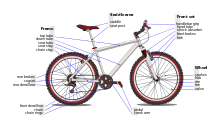Dustcap
A dustcap is a small cover used on the valve stem of a bicycle or car tire to prevent dust or other small particles from entering the valve and damaging it. The dustcap also forms a pressure seal, helping to prevent deflation of the tire due to slight gas seepage past the tire valve. Dustcaps are usually made from plastic but may occasionally be made of metal. The dustcap is internally threaded and is secured by screwing it onto the end of the stem. To prevent corrosion due to electrolysis and malfunction of the electronics in a direct TPMS and avoid costly repairs, metal valve caps without insulating plastic linings should not be used on direct-TPMS-equipped tire valve stems.
A dustcap may also refer, on a bicycle, to the crankarm bolt cover. It is usually a piece of metal or plastic that, on the crankarm, is snapped or screwed into the threaded counterbore, which houses the bolt that holds the crankarm to its axle, the bottom bracket spindle. The dustcap serves to protect the threads (on the inside of the counterbore), which are used with a crankarm puller to remove the crankarm from the spindle. It is also possible for the crank arm to squirm on the bottom bracket spindle, causing the crankarm nut/bolt to become loose, leading to the nut/bolt working its way out of the bottom bracket spindle. The dust cap limits the amount of dangerous loosening that can occur.
A dustcap may also refer, on a bicycle, to the metal ring that covers the bearings in a cup-and-cone ball-bearing hubset. These types of dust caps, being press-fit, are difficult to remove with bending or damaging them. It is suggested to press them out from the other side of the hub using a screw driver. In this role the dustcap reduces the dust that enters the bearing races, and extends service intervals.
